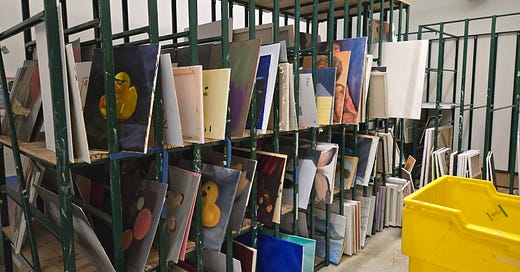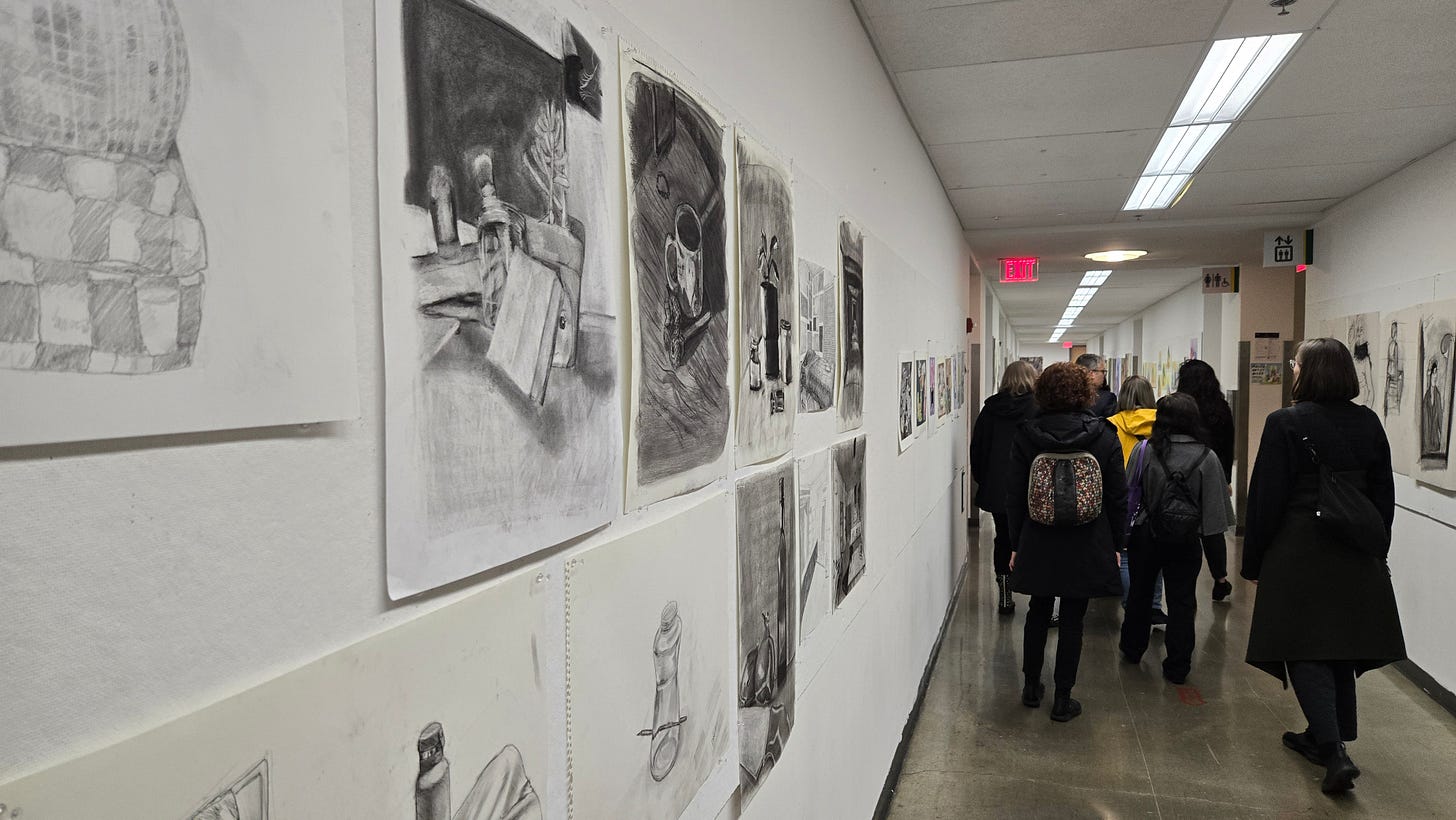Art and Design School: The First Year
How professors teach in foundations: The first year of the BFA
If you’ve spent time in art school, you know what this is:
These are paintings, made by students in a studio art class, in a storage room at George Mason University in their art and design building. I passed this room on a tour of the building with 300 artists and designers. We came to GMU last week for a bi-annual conference called “Foundations in Art: Theory and Education,” or FATE. This room wasn’t officially on the tour, but when I saw the paintings inside, I thought, this is the day-to-day world of teaching and learning art! Every semester, new students do paintings, and every semester, there are new paintings drying in this room.
My new book Learning to See is about how artists and designers teach in this building and in other ones like it all over the United States. I spent fifteen years interviewing artists and designers and watching what they do in their studio classes. In Learning to See, I share their stories—how they guide students through a personal transformation to new ways of seeing and thinking. It’s hard to describe and it sounds almost not possible. How can you teach someone how to see in a different way? But I saw it happening, and I’ve captured it in Learning to See.
The FATE conference is about “foundations”—the first year of a bachelor’s degree program in art and design. Students in every degree program take these courses, whether they’re going to become artists or designers. Foundations courses help you build a visual vocabulary and technical fluency. They give you the skills, knowledge, and understandings that you’ll need in every creative field. Here are some typical foundations courses:
Drawing. The fundamentals of observational drawing, focusing on line, shape, form, space, and perspective.
2D. The basic elements of design and principles of organization in two dimensions.
3D. Three-dimensional design concepts such as form, structure, and spatial dynamics.
Color. The use of color, perception, and its psychological impacts. Hue, saturation, value, color mixing, interactions of colors, application of color.
When these courses are taught well, you learn how to see and think in new ways. These art and design professors have developed a special way of teaching students how to create good work, consistently and deliberately. They’ve mastered something intangible and powerful: Teaching students how to see.
I took that photo of paintings drying during our tour of George Mason University’s art and design building. Here’s the building’s gallery, where they’d curated a juried show especially for this conference:
This is one of the student studios on our tour:
Here’s a hallway with student work from one of the classes. In an art school, the hallway walls are corkboard, designed for pushpins, and every available wall space is always filled.
Think back to when you were in college. Did your professor ever share your assignments with the whole university? Were the walls covered with student homework? Did you ever write a semester paper, or take a quiz, that was displayed in public? Did you ever see the work of another student? When you’re in art or design school, nothing you do stays private. If you don’t share, you don’t learn.
The official pub date of Learning to See is April 22nd, 2025. I just received my ten complimentary copies, and they look wonderful! Here’s my unboxing video! The book is printed in color and it has some unusual design features. It’s a book that you need to hold, and read and turn the pages—the physical object is wonderful. But the Kindle version looks great, too.
I didn’t go to art or design school. I never took a studio class. Maybe that’s why I’m so fascinated by hallways where you’re supposed to stick pins in the wall, or by students who get used to having everything they do shared with all of their peers. That’s why I’m so fascinated with what’s going on in these studios. When they’re empty, they’re just big rooms with seats and easels. When they’re filled with people, what’s going on? What kind of energy is that? How does it happen? I spent 15 years visiting art and design schools and I keep coming back. It never gets boring! That’s why I wrote Learning to See. If you’re thinking of going to art or design school, you need this book; it’ll tell you what’s going to happen. If you’re just starting to teach in art or design school, this book will tell you about the best and most experienced professors, and you can learn from them. I chose to interview professors with an average of almost 20 years of experience. They tell such compelling and articulate stories! That’s why I wrote this book: To tell their untold stories.
I’ll be interviewing many of these artists and designers on my podcast, The Science of Creativity. In fact, I’ve already interviewed illustrator John Hendrix, Episode 16, published December 15, 2024. Please subscribe to the podcast and you’ll stay informed about all of the amazing creators that will be on the show!
Have a great weekend! I keep reading that I’m supposed to post Tuesday through Thursday, in the morning. Here it is, Friday, after lunch. Oh well! If you’re reading this, then that means the timing was perfect for you, and that’s what matters to me!
Keith









Many similarities with music school, but some interesting differences too
Great